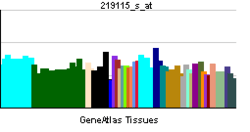Interleukin 20 receptor, alpha subunit
Interleukin 20 receptor, alpha subunit is a subunit for the interleukin-20 receptor. IL20RA is its human gene.[3]
The protein encoded by this gene is a receptor for interleukin 20 (IL20), a cytokine that may be involved in epidermal function. The receptor of IL20 is a heterodimeric receptor complex consisting of this protein and interleukin 20 receptor beta (IL20B). This gene and IL20B are highly expressed in skin. The expression of both genes is found to be upregulated in Psoriasis.[3]
References
Further reading
- Bonaldo MF, Lennon G, Soares MB (1997). "Normalization and subtraction: two approaches to facilitate gene discovery". Genome Res. 6 (9): 791–806. doi:10.1101/gr.6.9.791. PMID 8889548.
- Xie MH, Aggarwal S, Ho WH, et al. (2000). "Interleukin (IL)-22, a novel human cytokine that signals through the interferon receptor-related proteins CRF2-4 and IL-22R". J. Biol. Chem. 275 (40): 31335–31339. doi:10.1074/jbc.M005304200. PMID 10875937.
- Blumberg H, Conklin D, Xu WF, et al. (2001). "Interleukin 20: discovery, receptor identification, and role in epidermal function". Cell. 104 (1): 9–19. doi:10.1016/S0092-8674(01)00187-8. PMID 11163236.
- Dumoutier L, Leemans C, Lejeune D, et al. (2001). "Cutting edge: STAT activation by IL-19, IL-20 and mda-7 through IL-20 receptor complexes of two types". J. Immunol. 167 (7): 3545–9. doi:10.4049/jimmunol.167.7.3545. PMID 11564763.
- Wang M, Tan Z, Zhang R, et al. (2002). "Interleukin 24 (MDA-7/MOB-5) signals through two heterodimeric receptors, IL-22R1/IL-20R2 and IL-20R1/IL-20R2". J. Biol. Chem. 277 (9): 7341–7347. doi:10.1074/jbc.M106043200. PMID 11706020.
- Parrish-Novak J, Xu W, Brender T, et al. (2003). "Interleukins 19, 20, and 24 signal through two distinct receptor complexes. Differences in receptor-ligand interactions mediate unique biological functions". J. Biol. Chem. 277 (49): 47517–47523. doi:10.1074/jbc.M205114200. PMID 12351624.
- Strausberg RL, Feingold EA, Grouse LH, et al. (2003). "Generation and initial analysis of more than 15,000 full-length human and mouse cDNA sequences". Proc. Natl. Acad. Sci. U.S.A. 99 (26): 16899–16903. doi:10.1073/pnas.242603899. PMC 139241
 . PMID 12477932.
. PMID 12477932.
- Clark HF, Gurney AL, Abaya E, et al. (2003). "The secreted protein discovery initiative (SPDI), a large-scale effort to identify novel human secreted and transmembrane proteins: a bioinformatics assessment". Genome Res. 13 (10): 2265–2270. doi:10.1101/gr.1293003. PMC 403697
 . PMID 12975309.
. PMID 12975309.
- Mungall AJ, Palmer SA, Sims SK, et al. (2003). "The DNA sequence and analysis of human chromosome 6". Nature. 425 (6960): 805–811. doi:10.1038/nature02055. PMID 14574404.
- Pletnev S, Magracheva E, Kozlov S, et al. (2003). "Characterization of the recombinant extracellular domains of human interleukin-20 receptors and their complexes with interleukin-19 and interleukin-20". Biochemistry. 42 (43): 12617–12624. doi:10.1021/bi0354583. PMID 14580208.
- Ota T, Suzuki Y, Nishikawa T, et al. (2004). "Complete sequencing and characterization of 21,243 full-length human cDNAs". Nat. Genet. 36 (1): 40–45. doi:10.1038/ng1285. PMID 14702039.
- Sheikh F, Baurin VV, Lewis-Antes A, et al. (2004). "Cutting edge: IL-26 signals through a novel receptor complex composed of IL-20 receptor 1 and IL-10 receptor 2". J. Immunol. 172 (4): 2006–10. doi:10.4049/jimmunol.172.4.2006. PMID 14764663.
- Hör S, Pirzer H, Dumoutier L, et al. (2004). "The T-cell lymphokine interleukin-26 targets epithelial cells through the interleukin-20 receptor 1 and interleukin-10 receptor 2 chains". J. Biol. Chem. 279 (32): 33343–33351. doi:10.1074/jbc.M405000200. PMID 15178681.
- Zhang Z, Henzel WJ (2005). "Signal peptide prediction based on analysis of experimentally verified cleavage sites". Protein Sci. 13 (10): 2819–2824. doi:10.1110/ps.04682504. PMC 2286551
 . PMID 15340161.
. PMID 15340161.

 . PMID 12477932.
. PMID 12477932. . PMID 12975309.
. PMID 12975309. . PMID 15340161.
. PMID 15340161.